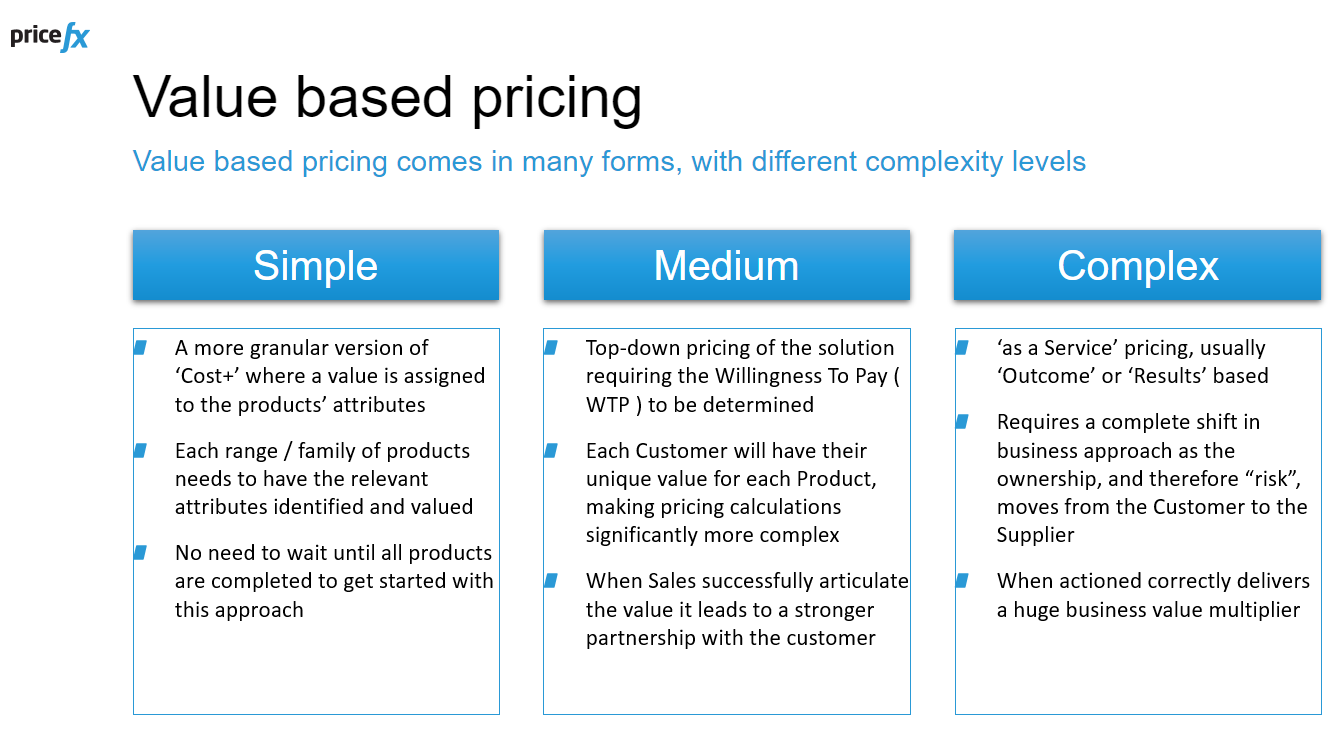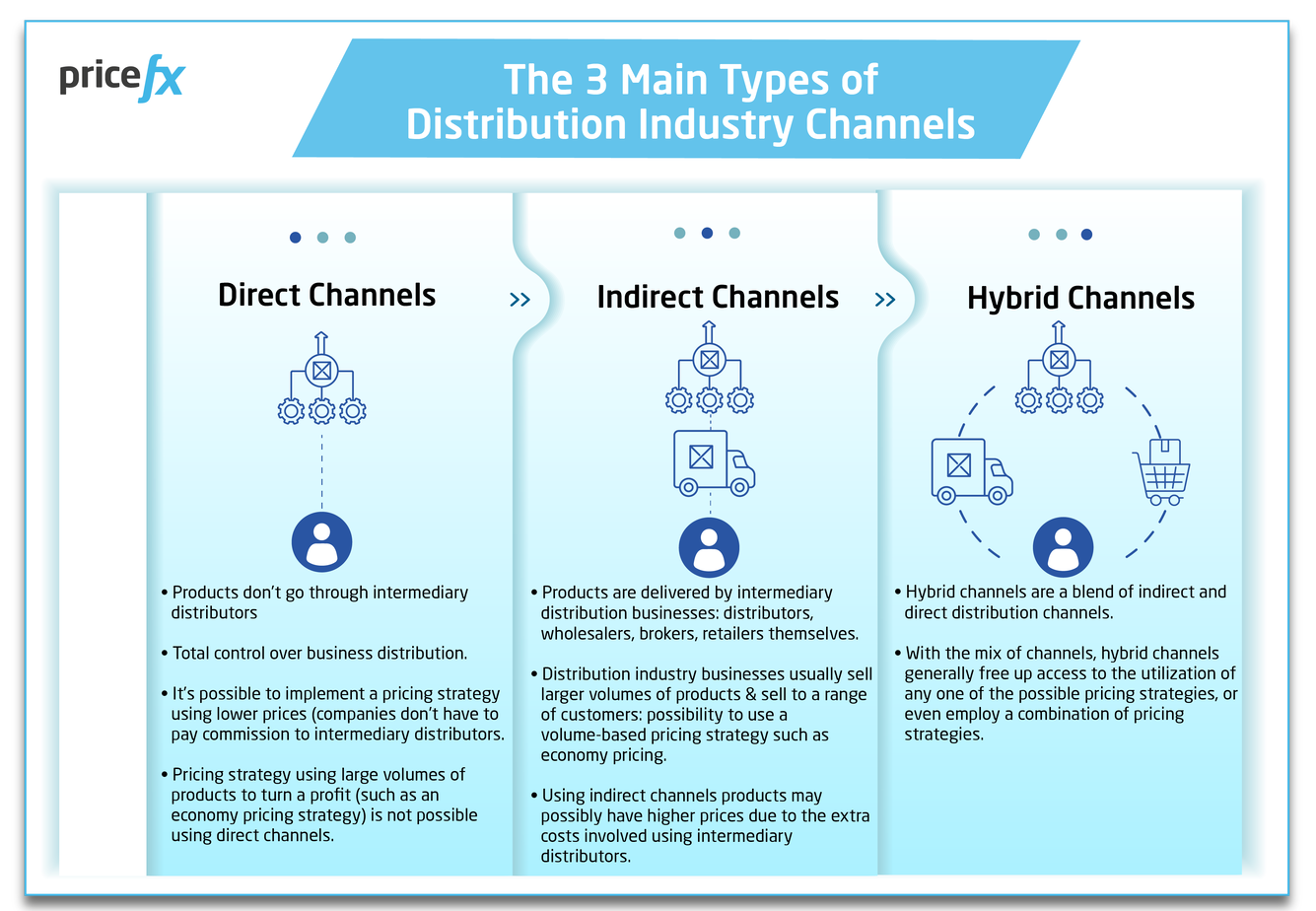Distribution Industry Pricing Strategies: Tips, Types & Examples
May 20th, 2022 (Updated 03/10/2023) | 12 min. read
By Iain Lewis
As a business trying to make it in the ultra-competitive Distribution Industry, you face some unique challenges that other industries don’t need to be concerned about. Your business is currently facing more disruptions than any other industry as you are the critical lynchpin in the heavily disturbed supply chain between manufacturers on the one hand, and retailers on the other. What’s more your transportation overheads are currently priced through the roof, and labor (if you can get it) costs are rising steadily too. No wonder considering or even re-examining your distribution industry pricing strategy will be critical to your ongoing success.
At Pricefx, we have spent more than decade assisting our clients to make data-informed and real-time pricing decisions for their distribution industry businesses, helping them run more pricing-efficient organizations and empowering them to protect their profits.
In this article, we will analyze the best pricing strategies that many distributors may find advantageous, the three main types of distribution channels (and how that may affect your distribution pricing strategy) and tips for re-enforcing profitability through flexibility in your distribution pricing strategy in the current continuously evolving market conditions.
Types of Distribution Pricing Strategies & What is Right for Your Business
There is no one single correct answer to advise what is the best pricing strategy for your distribution business. Your pricing strategy should be unique to your specific organization and reflect your company’s preferences, strengths and weaknesses, and of course, consider the overall objectives that your business is trying to achieve. That said, there will be some commonality between your pricing strategy and that of your distribution industry competitors.
Aim to make logical and scientific data-informed pricing decisions. That is the clear gateway to discovering the precise price optimization points for your distribution business to eliminate margin leakage and maximize your company’s profits.
However, there may be different pricing strategies that you could seek to employ to reach that end profit goal including;
- Competitive Pricing Strategy – A competitive pricing strategy (a pricing method that involves setting the prices of your products in relation to the prices of your competitors) is often referred to as a ‘Manufacturer-Aligned Pricing Strategy’ within the distribution sectors. Distributors will often all sell the same product from the same manufacturer using the same manufacturer’s recommended price (often known as the Manufacturer List Price).
- Cost-Plus Pricing Strategy – Cost-plus pricing is sometimes also referred to as ‘markup pricing’ Cost-plus is a pricing strategy whereby a fixed percentage or fixed amount is added on top of the manufacturing and distribution costs of a single unit, resulting in the selling price of your specific product/s.
- Economy Pricing Strategy – An economy pricing strategy sets your prices as low as possible to make a small profit on each item. The concept is based on selling as many units as possible of your product/s as possible. Being based on volume selling, this type of pricing strategy is also commonly referred to as ‘volume-based’ pricing strategy.
- Penetration Pricing Strategy – Penetration pricing is a pricing strategy that is used by new companies to gain a significant market share quickly by setting an introductory low price to entice customers to buy their products. Established companies also use the strategy when launching new products to build market share.
- Value-based Pricing – Value-based pricing is a strategy of setting prices primarily based on a consumer’s perceived value of a product or service —also known as customers’ willingness to pay—to determine the price it will charge. Because it revolves around customers’ priorities, it’s occasionally called customer-focused pricing. However, a great value-based pricing strategy should consider the value you place on your products as a distributor.

Why Pricing is Different for Distributors – Important Points for Your Pricing Strategy
Whichever pricing strategy you choose for your distribution business, you should be aware that as a distributor there are three key factors that you need to consider – storage costs, product availability and regular pricing reviews.
Storage Costs
As Distributors, you are adding value to your products for your customers by having a range of products ready on your shelves available and waiting to ship. Without placing stock on your shelves, it will place significant unwanted and extra pressure on your customer relationships and your business. To maintain those important customer liaisons, the chances are that you are also adding on extras such as shipping, servicing, or installation.
The storage costs and added extras you provide all increase the value of your products in the eyes of your customers. Acknowledge that when you are setting a pricing strategy for your business.
Product Availability
Due to any number of recent and current extenuating circumstances (such as the global pandemic, Brexit, labor shortages, the war in Ukraine etc.), product availability itself is becoming an important factor in your pricing strategy.
For example, if you are an electronics or car manufacturer, if you currently have a supply of computer chips to insert into products, then you automatically find yourself in an incredibly strong ‘price position’.
Regular Pricing Reviews
Regardless of the type of pricing strategy your distribution company implements, instituting a regular price review will be critical.
A SMART (specific/measurable/achievable/realistic/targeted) pricing review on a regular basis across your different pricing segments should assist in making your reviews more accurate.
Of course, each distribution pricing company is different. Consequently, the cadence of your regular pricing review (whether its once per month or once per quarter etc.) will be guided by your company’s unique business objectives.
The 3 Main Types of Distribution Industry Channels & Their Effects on Your Chosen Pricing Strategy

Another unique factor that distributors need to face in determining the pricing strategies that they implement are the channels of distribution used by your business. Distribution channels are the pathways your products take from the manufacturing stage to selling them to customers. Usually, the goal of distribution channels is to make your products available for purchase to customers in stores as soon as possible. Distribution channels can directly impact on your company’s profit, so making them as efficient as they can be is critical.
There are three main pathways a product gets from a factory or warehouse, and into the hands of customers.
1. Direct Channels
As the name implies, with direct channels, products do not go through intermediary distributors before reaching the final stop for sale. Direct channels provide manufacturing businesses with total control over their own distribution, such those types of companies participating in catalogue sales, for example.
When using a direct distribution channel, it becomes possible to implement a pricing strategy using lower prices as those companies do not have to pay commission or costs to intermediary distributors.
However, a pricing strategy using large volumes of products to turn a profit (such as an economy pricing strategy for example) is not possible using direct channels.
2. Indirect Channels
On the other hand, indirect channels products are delivered by intermediary distribution businesses, not the manufacturers.
For example, they can be distributors, wholesalers, brokers, or even the retailers themselves.
Distribution industry businesses using indirect channels usually sell larger volumes of products and sell to a range of customers, opening the possibility to use a volume-based pricing strategy such as economy pricing. However, using indirect channels, products may possibly have higher prices due to the extra costs involved using intermediary distributors.
3. Hybrid Channels
Hybrid channels are a blend of indirect and direct distribution channels.
With the mix of channels, hybrid channels generally free up access to the utilization of any one of the possible pricing strategies, or even employ a combination of pricing strategies.
Tips in Setting a Lean & Efficient Distribution Industry Pricing Strategy
Consider these tips when looking to apply a pricing strategy for your distribution company to make it more robust, in these rapidly evolving and uncertain times;
Set clear business objectives and breakdown your pricing plan – Your business objectives will be the critical component in deciding which pricing strategy you implement for your distribution company.
Will you be looking to simply increase revenue, or will you seek to turn small profits per item based on a large sales volume? Choose and execute a pricing strategy that best reflects your company goal and how you expect to realize it.
Furthermore, break down your business objectives as much as you can. Examine your larger plan and break it down into more detailed strategic plans as much as possible. For example, if your organization’s goal for the fiscal year is to increase revenue by $5 million for the year, having a plan to know where that $5 million will be made up from across your various products, different market etc. will be important.
Use Data Analysis to Enhance the Outcome of your Chosen Pricing Strategy: Applying a pricing strategy that can keep pace with the rampant current rate of change in inflation, rising fuel prices and supply chain disruption is key, and data-informed pricing software is best way to achieve that.
If you have an unlimited army of employees to input data 24-7 into Excel spreadsheets then it may be possible without pricing software, but who can, or even more importantly, wants to do that?
Regardless of which pricing strategy you implement, enhancing your pricing response times is critical to avoid margin leakage.
Identify and understand value drivers for your products at a granular level: Data tracking at granular levels is vital in optimizing your prices. Check your product list to identify and manage the value drivers to assist your company to focus on the value of your products.
That focus can empower your business into taking specific actions to deliver the most value for your products.
Food and Beverage and grocery product distributors, for instance, have high everyday inventory turnover and therefore less storage costs to build into pricing. On the other hand, heavy machinery distributors experience low inventory turnover as they are usually not everyday purchases.
Some products can also turnover quicker than others within the same industry. For example, in the automotive distribution sector, exhaust systems are usually replaced less often than car batteries or tires. Understanding those differences at a granular level is important as you will need to factor in the larger ongoing storage costs of those exhaust systems.
Understand your products’ value to customers & price appropriately – Of top value to your customers is having a supply of your products on the shelf, ready for sale and immediate shipment.
For example, with the outbreak of another pandemic, imagine a chain of medical clinics came to you needing a supply of face masks and other personal protective equipment (PPE). You have a good PPE supply sitting on your warehouse shelves.
Will you simply add your usual 1.5% quarterly mark-up to your PPE prices, or will you value-price and price the PPE at what you know them to be worth, factoring in your demand foresight and storage costs?
Value Added Services (VAS) – Consider offering additional services and accessories and building them into your value-based pricing strategy. You might look at offering delivery, advice, self-service apps, installation, ongoing maintenance, testing, calibration, and servicing on your products.
Another popular method is what is known as ‘broken box’. What that means is taking a huge box of your products, with say 1000 pieces inside, and breaking it down into 10 boxes of 100 to appeal to your smaller customers. ‘Production ready packaging’ is another form of value adding whereby items that are used in manufacturing are shipped to clients package-ready to feed into the production line.
Not only do VAS build plenty of extra profit opportunity for your business, but they also assist in building and strengthening your customer relationships with your clients. A happy customer will almost certainly return to buy from you again in the future.
However, make sure your Sales Team understand the value behind your VAS and invoice them at their full fair value, rather than give them away for free.
Discuss Pricing Strategy with your Sales and Marketing Team – Much of your company’s customer knowledge rests with your sales and marketing teams. When setting your pricing strategy, where your customers live, their ages, regions, business types (if you sell business-to-business) and other demographics are all crucial factors.
Clean and granular data sets are important and having your sales team collect prospect and customer data as part of their KPIs will assist in implementing a more accurate pricing strategy, in addition to recognizing the value of VAS as we noted above.
Marketing Teams also collect unique data sets that can assist in implementing pricing strategies like new business acquisitions, price increases, tracking competitor prices and inventories, new and discontinued product lines etc.
Empower Data Collection Through a Pricing Project Champion or Ultimate Decision Maker – At all points of the processes outlined above, data needs to be available to enable the accuracy of your pricing strategy.
If data is not being collected, drive its collection through the support of your Pricing Manager or an appropriate person at the C or VP level of your distribution business. Executive buy-in of data collection will be a decisive part of the accuracy of your strategy.
I’ve Decided on a Distribution Pricing Strategy – Where to Now?
After reading this article on distribution pricing strategies, you are now fully informed on the tips and tricks to help you decide on and implement a customized pricing strategy to help your business prosper, drive growth and profit.
You have possibly already chosen the best pricing strategy that fits your organization’s unique business objectives. It may have also become clearly apparent that to implement the required level of granularity in your strategy next generation pricing software like Pricefx will be needed to put it into action.
However, are you wondering how to begin implementing your very-own personalized, granular, and future-proofed distribution pricing strategy?
If you would like to learn more about how to implement a unique pricing strategy for your distribution company business, check out the advice this practical article below:

